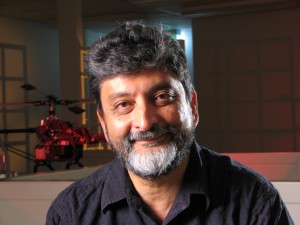 Mandyam Veerambudi Srinivasan
Mandyam Veerambudi Srinivasan
An automatic landing system for an aircraft is expensive and complex. And it is just one of many systems that would be required to make a truly robotic aircraft.
But a bee can take off, find targets, fly through tunnels, navigate home, and land without any of that complexity. It uses a minute brain of about a million nerve cells, which is the size of a sesame seed and weighs just a tenth of a milligram.
Mandyam Srinivasan – known to all as Srini – has dedicated his research career to understanding just how bees work.
What started 23 years ago as basic research with no apparent application, is now followed closely by robotics experts around the world, and routinely receives NASA and US military grants.
Mandyam Veerambudi Srinivasan FAA FRS receives the 2006 Prime Minister’s Prize for Science for a remarkable and unique research career that has revealed the working of the insect mind, and helped redefine robotics research.
Srini first gained a Masters in Electrical Engineering in his home town of Bangalore in India before turning his attention to exploring the links between human vision and engineering.
After a PhD at Yale University, and work at the Australian National University and the University of Zurich, Srini returned to ANU in 1985 to join a major project on an exploration into how insects perceive the three-dimensional world and manoeuvre in it.
It was then that he started a series of elegant experiments with bees that combine biology and engineering, and have transformed our understanding of the insect world. He has found that:
1) Bees fly through the middle of a tunnel by balancing the speeds of the images in the two eyes. Four robotics laboratories have used these results to construct robots that navigate through corridors.
2) Bees regulate their flight speed by matching the speed of the images in each eye. They fly fast in open terrain and slow down to a safer speed in densely cluttered terrain.
3) Honeybees measure distance flown in terms of the extent to which the image of the environment moves in the eye. Thus, bees possess a visually-driven “odometer”.
4) Bees land smoothly by ensuring that their view of the surface stays at a constant speed. As the surface gets closer it appears to be moving faster, so the bee slows down. The result – a perfect landing – and a landing technique that Srini is now trialling using model aircraft.
Srini’s findings are informing robotics research around the world. His team’s projects include:
- a robot that can steer through cluttered environments, supported by Fujitsu;
- a camera that can give panoramic, insect-like vision to robots and surveillance cameras;
- an autonomous navigation system for helicopters, with help from the US Defence Advanced Projects Agency; and
- a design for ‘micro flyers’ for NASA. A mother craft would land on Mars and release several small, relatively inexpensive, autonomous micro flyers to survey the surrounding terrain.
One of his current projects looks at angry bees. When their hive is threatened, bees rush out and immediately attack any moving object in range. The US Air Force is interested in this capability.
What of the future? “Today we are trying to create small conventional aircraft with the brains of a bee. The future challenge is to bring in the engineering of a bee – micro flyers that can do what bees do,” says Srini.
But Srini is most excited about the potential to learn about emotion and cognition from bees.
“I’ve seen bees show frustration, anger, even joy,” he says. “I’m planning a new series of experiments that will determine if they really can experience emotion. If so, bees could transform our view of emotion and cognition across the animal kingdom.”
Autobiographical details
Qualifications
1994 D.Sc. in Neuroethology, Australian National University.
1977 Ph.D. (Engineering and Applied Science), Yale University, New Haven, Connecticut, USA
1973 M.Phil. in Engineering and Applied Science, Yale University, New Haven Connecticut, USA
1970 Masters’ degree in Applied Electronics & Servomechanisms (High Distinction), Indian Institute of Science, Bangalore, India
1968 Bachelors’ degree in Electrical Engineering (First Class), Bangalore University, India
Current positions
Inaugural Federation Fellow, Australian Research Council
ANU Distinguished Professor, Research School of Biological Sciences, Australian National University
Director, Centre for Visual Science, Australian National University
Previous Appointments
1992-93 Senior Fellow, Visual Sciences, Research School of Biological Sciences, Australian National University
1985-91 Fellow, Visual Sciences, Research School of Biological Sciences, Australian National University
1982-85 Assistant Professor of Biophysics, Department of Neurobiology, University of Zürich, Switzerland.
1978-82 Research Fellow, Departments of Neurobiology and Applied Mathematics, Australian National University
1977-78 Research Scientist, Department of Ophthalmology and Visual Science, Yale University School of Medicine, New Haven, Connecticut, USA
Research interests
Principles of visual processing in simple natural systems, and their application to machine vision and robotics.
Awards and Distinctions
2006 2006 Royal Society of New Zealand Distinguished Visitor
2003 Australian Centenary Medal
2002 Doctor honoris causa (Dr.h.c.), University of Zürich
2001 Election to the Fellowship of the Royal Society of London (FRS)
2001 Inaugural Australian Federation Fellowship award
2001 Australasian Science Prize
1996-97 Daimler-Benz Fellow (Wissenschaftskolleg), Institute of Advanced Studies, Berlin.
1995 Election to the Fellowship of the Australian Academy of Science (FAA).
1973 Marshall, M.Phil. Degree Ceremony, Yale University.
1970 Khambatti Memorial Award for top graduate student in Electrical Engineering,
Indian Institute of Science, Bangalore.
1967 First rank (out of 500 students), Fourth Year Electrical Engineering, Bangalore University
Publications
161 full-length research publications, including 15 in journals such as Nature and Science, 35 reviews, 1 edited book, 2 international patents.
Grants
2001-05 $5.0 million from the ARC, and Australian and overseas defence research organisations.
Major lectures
2001-05 35 invited keynote, plenary, opening, and named lectures at international and national conferences. Address to the Prime Minister’s Science, Engineering and Innovation Council, 5 December 2002. 2006 Royal Society of New Zealand Distinguished Visitor


